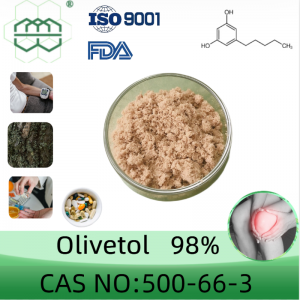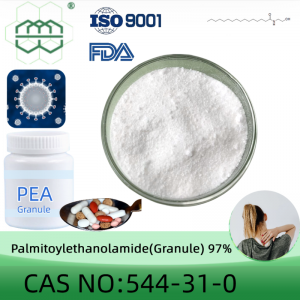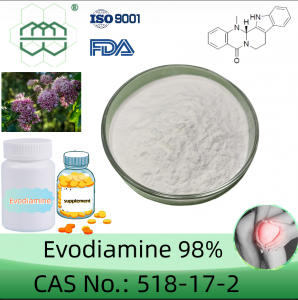Oleoylethanolamide (OEA) powder manufacturer CAS No.: 111-58-0 98%,85% purity min. for supplement ingredients
Product Parameters
|
Product name |
Oleoyl ethanolamide |
|
Other name |
N-oleoyl ethanolamine; N-(2-hydroxyethyl)-,(Z)-9-Octadecenamide |
|
CAS No. |
111-58-0 |
|
Molecular formula |
C20H39NO2 |
|
Molecular weight |
325.53 |
|
Purity |
98.0% ,85.0% |
|
Appearance |
Fine white crystal powder |
|
Packing |
1kg/bag, 25kg/drum |
|
Application |
Pain relief, anti-inflammatory |
Product introduction
Oleoylethanolamide is a secondary amide compound composed of lipophilic oleic acid and hydrophilic ethanolamine. Oleoylethanolamide is also a naturally occurring lipid molecule in other animal and plant tissues. It is widely present in animal and plant tissues such as cocoa powder, soybeans, and nuts, but its content is extremely low. Only when the external environment changes or food is stimulated, the body's cell tissues Only then will more of this substance be produced.
At room temperature,Oleoylethanolamide is a white solid with a melting point of about 50°C. It is easily soluble in alcoholic solvents such as methanol and ethanol, more easily soluble in non-polar solvents such as n-hexane and ether, and insoluble in water. OEA is an amphiphilic molecule traditionally used as a surfactant and detergent in the chemical industry. However, further research found that OEA can serve as a lipid signaling molecule in the gut-brain axis and display a series of biological activities in the body, including: controlling appetite, improving lipid metabolism, enhancing memory and cognition and other functions. Among them, Oleoylethanolamide's functions of controlling appetite and improving lipid metabolism have received the most attention.
Oleoylethanolamide can regulate food intake and energy homeostasis by activating peroxisome proliferator-activated receptor-α. In addition, Oleoylethanolamide exhibits other health-related activities, including modulating converter activity in the lysosomal-to-nuclear signaling pathway associated with longevity regulation and protecting nerves that control depressive behaviors. Research also suggests that Oleoylethanolamide may have neuroprotective effects. In animal models, it has been found to reduce damage from stroke and traumatic brain injury. The regulatory effect of Oleoylethanolamide is attributed to its binding to PPARα, which dimerizes with the retinoid X receptor (RXR) and activates it as a potent transcription factor involved in combined energy homeostasis, lipid metabolism, autophagy, and inflammation. downstream targets.
Feature
(1) High purity: OEA can obtain high-purity products through refining production processes. High purity means better bioavailability and fewer adverse reactions.
(2) Safety: OEA has been proven to be safe for the human body.
(3) Stability: OEA has good stability and can maintain its activity and effect under different environments and storage conditions.
(4) Easy to absorb: OEA can be quickly absorbed by the human body and distributed to different tissues and organs.
Applications
Oleoylethanolamide is a natural ethanolamide lipid used as a dietary planning and body weight regulator in a variety of vertebrate species. It is a metabolite of oleic acid formed in the human small intestine. Oleylethanolamide (OEA) is a molecule that regulates lipid metabolism and energy homeostasis. It sticks to PPAR Alpha receptors and helps control four factors: hunger, body fat, cholesterol and weight. PPAR Alpha represents peroxide proliferator-activated receptor alpha, and the bioactive lipid amide oleoylethanolamide (OEA) has a variety of unique homeostatic properties, including anti-inflammatory activity, immune response modulation, and antioxidant effects.



















